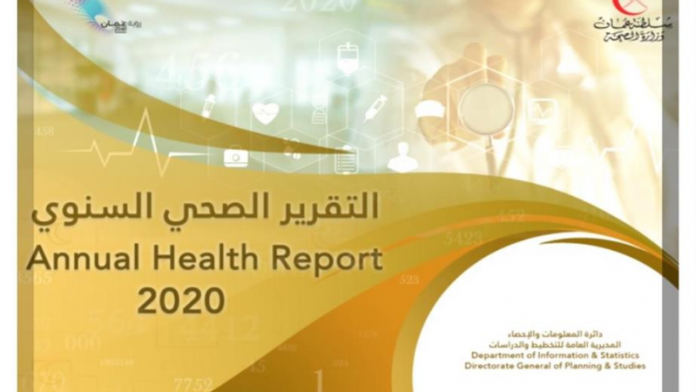Muscat: The Ministry of Health (MOH), represented by the Information & Statistics Department of the Directorate General of Planning & Studies issued the Annual Health Report 2020.
The report highlights the main services provided by the health sector in 2020 along with health & vital indicators and the sustainable development goals indicators. The report contains a brief for the most important MOH studies and researches over the past years.
The annual health report 2020 started with an introduction about the demographic and geographic features of the Sultanate in addition to the administrative structure and organization of the Ministry. Most of the health indicators are revealed in this report in a time series of the past year.
The report shows a description and development of the indicators related to various health fields of the Ninth Five-Year Plan and the achievements that have been made within the five years of the plan, in addition to an overview of the Tenth Five-Year Plan, its objectives, and related indicators.
Chapter 10 of the annual health report describes the available health services provided by other government authorities other than the Ministry of Health along with data on the private sector.
A number of publications have emerged from the Annual Health Reports 2020 including “Health Facts of the Annual Health Report” and health facts about the reported births and deaths in all health institutions in the Sultanate. These publications contain some indicators in the form of tables and graphs. Moreover, reports were issued from the annual health report, which was professionally produced using geographical systems, such as “Statistical Overview” and the “Statistical Indicators with Spatial Data” report.
The annual health report 2020 shows an increase in the expenditures of the Ministry of Health compared to the previous three years (2017-2019). The report indicated that the total recurrent expenditures in MOH amounted to approximately RO 972.5 million during the year 2020 compared to approximately RO 793.3 million in 2019, reflecting a 22.6% increase. In contrast, development expenditures decreased from RO 21.6 million in 2019 to RO 15.7 million in 2020.
The total number of health centres and polyclinics operated by the Ministry reached 211, including (54) health centres with a capacity of (84) beds, and (21) polyclinics, in addition to (51) hospitals comprising (5,262) beds by the end of 2020. Many services were also added to these institutions in order to improve the quality of health services provided at all levels. A field hospital for Covid-19 cases was designated, equipped with 202 beds.
The total number of workers in the Ministry of Health reached (38,566) employees by the end of December 2020, with an Omanization rate of 73%.
Regarding vital indicators, the crude birth rate among Omanis was 28.6 per 1000 population in 2020 while the crude death rate among Omanis was 3.2 per 1000 population in the same period. The death rate among children under five years of age decreased to 9.3 per 1000 live births in 2020 compared to 10.2 per 1000 live births in 2019, and the infant mortality rate (less than one year) per 1000 live births decreased from 8.0 to 7.6 for the same period.
The report also showed the control of measles disease, where no case of the diseases has been recorded in 2020. The Sultanate has remained free of many diseases such as polio since 1993, diphtheria and neonatal tetanus since 1991. The incidence rates of other communicable diseases have decreased to lowers levels. For instance, the number of malaria cases dropped to 276 cases in 2020 compared to 1338 cases in 2019.
COVID-19 pandemic has posed a great challenge to all health systems, whether in the most or least developed countries in the world. The health system in the Sultanate, along with all state apparatus, has confronted this challenge with efficiency and competency, relying on the strong infrastructure that was built over the years and on the competencies of its human resources for health, implementing simultaneously all international standards and policies set for the fight against this pandemic.
Furthermore, the report touches upon morbidity and mortality pattern. The statistics indicate a change in the epidemiological map in the Sultanate as Coronavirus disease has changed the equation of the epidemiological change in the Sultanate similarly to the rest of the world. Therefore, the report showed high death rates due to communicable diseases.
The decrease in the use of health services in 2020 is attributed mainly to the effect of the COVID-19 pandemic. The number of outpatient clinics visits to MOH institutions in 2020 dropped to 10.5 million visits compared to about 15.7 million visits in 2019.
The average number of visits per Omani person to outpatient clinics reached (3.7) during 2020, which led to a decrease in the total number of discharged patients from MOH’s health institutions to reach about 257000 in 2020, with an average period of hospitalization (3.7) days of stay and 47.8% of bed occupancy rate.
The report also showed the various surgical operations that were performed at the theatre rooms of MOH’s institutions, where the total number of surgeries reached about 52.7 thousand surgeries in 2020, at a rate of 11.4 surgery per 1000 population. The report includes further plenty of statistics on health services use such as admissions, radiology, and dialysis services, and others.
The MOH’s Directorate General of Planning & Studies is the central body responsible for providing reliable and accurate information, as well as data for each planning, monitoring and evaluation process in a timely manner thus contributing in the proper planning and decision-making procedures. Information is made available to all health workers in the various departments and sections.
Moreover, the Department of Information and Statistics is providing the Sultanate’s health indicators to the international organizations and bodies including World Health Organization (WHO) and The United Nations Children’s Fund (UNICEF), in addition to the academic and research centres.






